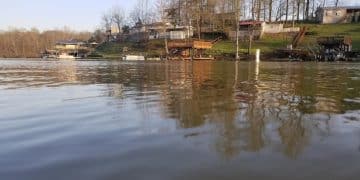Extreme Weather Events in the US: Climate Change Impact in Last 3 Months

Extreme weather events in the US have been increasingly scrutinized for their link to climate change. Over the last three months, studies and data suggest that a significant portion of the intensifying heatwaves, hurricanes, and floods can be attributed to the ongoing effects of climate change, raising concerns about future resilience and adaptation strategies.
The United States has been grappling with a series of extreme weather events, from scorching heatwaves to devastating hurricanes and widespread floods. Understanding the extent to which climate change has contributed to these events in the last three months is crucial. Let’s delve into the data and expert analyses to uncover the climate change link to extreme weather events in the US: How Much Did Climate Change Contribute in the Last 3 Months?
Recent Extreme Weather Trends in the US
Over the past few months, the US has witnessed a surge in extreme weather events, prompting questions about the underlying causes. These events, ranging from record-breaking temperatures to intense rainfall, have affected communities across the nation. Let’s explore the specific trends that have emerged during this period.
Heatwaves and Record Temperatures
One of the most notable trends has been the prevalence of heatwaves, with many states experiencing temperatures far above historical averages. These prolonged periods of intense heat have posed significant risks to public health, agriculture, and infrastructure.
The intensity and duration of these heatwaves have raised concerns among climatologists, who point to climate change as a major contributing factor.
Increased Rainfall and Flooding
In addition to heatwaves, several regions have faced unusually heavy rainfall, leading to widespread flooding. These events have resulted in property damage, displacement of residents, and disruptions to transportation networks.
- Rapid Onset: The speed at which these floods develop often catches communities off guard.
- Infrastructure Strain: Aging infrastructure is proving inadequate to handle the increased water volume.
- Economic Impact: Businesses and homeowners face significant financial losses due to flood damage.

These trends highlight the growing vulnerability of communities to extreme weather, underscoring the need for better preparedness and mitigation strategies. By understanding the nature and scope of these events, we can better assess the role of climate change.
The Science Linking Climate Change to Extreme Weather
The scientific community has been actively studying the connection between climate change and extreme weather events. While it is challenging to attribute any single event solely to climate change, researchers have developed methods to assess the extent of its contribution. Let’s examine the scientific evidence that supports this linkage.
Attribution Science Explained
Attribution science is a field of research that seeks to quantify the influence of climate change on specific weather events. Using climate models and historical data, scientists can estimate how much more likely or intense an event was due to human-caused climate change.
This approach allows for a more nuanced understanding of the relationship between climate change and extreme weather.
Key Studies and Findings
Several recent studies have shed light on the role of climate change in exacerbating extreme weather events. These studies have focused on different types of events, including heatwaves, hurricanes, and floods.
For example, a study published in “Nature Climate Change” found that the recent heatwave in the Pacific Northwest was made significantly more likely due to climate change.
- Temperature Increases: Climate change has been shown to increase the average global temperature, leading to more frequent and intense heatwaves.
- Sea Level Rise: Rising sea levels exacerbate coastal flooding during storms, increasing the extent of damage.
- Changes in Precipitation Patterns: Climate change is altering precipitation patterns, leading to more intense rainfall in some areas and droughts in others.
The scientific evidence is becoming increasingly clear: climate change is not just a future threat but is already impacting weather patterns in the US.
Regional Impacts Across the United States
The effects of extreme weather events are not uniform across the United States. Different regions face unique challenges based on their geography, climate, and infrastructure. Understanding these regional impacts is essential for developing targeted adaptation strategies. Let’s explore how various parts of the country are being affected.
The West Coast: Droughts and Wildfires
The West Coast has been particularly vulnerable to prolonged droughts, leading to increased wildfire risk. These conditions have had devastating consequences for forests, communities, and economies.
The combination of heatwaves and dry vegetation has created a perfect storm for wildfires, which have become larger and more destructive in recent years.
The Gulf Coast: Hurricanes and Coastal Flooding
The Gulf Coast is highly susceptible to hurricanes and coastal flooding, which are becoming more intense due to climate change. Rising sea levels and warmer ocean temperatures are contributing to the increased frequency and strength of these storms.

The economic and social impacts of these events are significant, with communities facing long-term recovery challenges.
The Midwest: Extreme Rainfall and Agriculture
The Midwest has experienced an increase in extreme rainfall events, which have had detrimental effects on agriculture. Flooded fields and delayed planting seasons have led to crop losses and economic hardship for farmers.
The changing precipitation patterns are disrupting traditional farming practices and requiring adaptation measures.
Economic Costs of Extreme Weather
The economic costs of extreme weather events are substantial and growing. These costs include damage to property, disruptions to businesses, and increased healthcare expenses. Understanding the economic impacts is crucial for justifying investments in climate resilience.
Direct and Indirect Costs
The direct costs of extreme weather events include the expenses associated with repairing or replacing damaged infrastructure, homes, and businesses. Indirect costs include lost productivity, reduced tourism, and increased insurance premiums.
Long-Term Economic Impacts
Beyond the immediate costs, extreme weather events can have long-term economic consequences. For instance, repeated flooding can lead to a decline in property values, and prolonged droughts can affect agricultural productivity for years to come.
- Infrastructure Damage: Roads, bridges, and other critical infrastructure are vulnerable to damage from extreme weather.
- Business Disruptions: Businesses may be forced to close temporarily or permanently due to weather-related damage.
- Healthcare Costs: Heatwaves and other extreme events can lead to increased hospitalizations and healthcare expenses.
The economic burden of extreme weather is a significant challenge for communities and governments, underscoring the need for proactive measures to reduce risk.
Adaptation and Mitigation Strategies
Addressing the challenges posed by extreme weather requires a two-pronged approach: adaptation and mitigation. Adaptation involves taking steps to reduce vulnerability to the impacts of climate change, while mitigation focuses on reducing greenhouse gas emissions to slow down the rate of warming. Let’s explore some of the strategies being employed in the US.
Investing in Resilient Infrastructure
One of the key adaptation strategies is to invest in resilient infrastructure that can withstand extreme weather events. This includes building stronger seawalls, improving drainage systems, and constructing more durable buildings.
Resilient infrastructure can help communities better cope with the impacts of climate change.
Reducing Greenhouse Gas Emissions
Mitigation efforts are essential for addressing the root cause of climate change. This involves reducing greenhouse gas emissions through measures such as transitioning to renewable energy, improving energy efficiency, and promoting sustainable transportation.
The US has set ambitious goals for reducing emissions, but more action is needed to meet these targets.
- Renewable Energy: Investing in solar, wind, and other renewable energy sources can reduce reliance on fossil fuels.
- Energy Efficiency: Improving energy efficiency in buildings, transportation, and industry can lower emissions.
- Sustainable Transportation: Promoting public transportation, electric vehicles, and cycling can reduce emissions from the transportation sector.
By combining adaptation and mitigation strategies, the US can better protect its communities and economy from the impacts of extreme weather.
Policy and Public Awareness
Policy and public awareness play a crucial role in addressing the challenges posed by extreme weather and climate change. Effective policies can incentivize adaptation and mitigation efforts, while increased awareness can empower individuals and communities to take action. Let’s examine the role of policy and public awareness in shaping the response to climate change.
The Role of Government Policies
Government policies at the federal, state, and local levels can have a significant impact on climate change. These policies can include regulations, incentives, and investments aimed at reducing emissions and promoting resilience.
For example, the Inflation Reduction Act includes provisions for clean energy tax credits and investments in climate resilience.
Raising Public Awareness
Increased public awareness is essential for building support for climate action. This involves educating people about the risks of climate change and the steps they can take to reduce their carbon footprint.
| Key Point | Brief Description |
|---|---|
| 🔥 Heatwaves | Increased frequency and intensity due to climate change. |
| 🌊 Flooding | Heavier rainfall and rising sea levels exacerbate flood risks. |
| 🌱 Agriculture | Extreme weather disrupts planting and harvesting, impacting yields. |
| 🌎 Policy | Government and community initiatives are crucial in mitigation. |
Frequently Asked Questions
▼
Climate change has significantly increased the likelihood and intensity of heatwaves. Studies show that some heatwaves would have been virtually impossible without human-caused warming, thereby exacerbating risks to public health and ecosystems.
▼
Increased flooding is primarily driven by heavier rainfall events and rising sea levels. Climate change intensifies the water cycle, leading to more extreme precipitation. Rising sea levels also exacerbate coastal flooding during storms, causing broader damage.
▼
Extreme weather severely disrupts agriculture by causing crop failures, livestock losses, and soil erosion. Heatwaves, droughts, and floods damage crops and reduce yields. Unpredictable weather patterns also make it challenging for farmers to plan and manage their operations.
▼
Communities can implement several adaptation strategies, including investing in resilient infrastructure, improving land-use planning, and enhancing emergency preparedness. Building stronger seawalls, upgrading drainage systems, and promoting sustainable farming practices can help minimize the impacts.
▼
Policies play a crucial role by setting emission reduction targets, incentivizing renewable energy, and regulating carbon emissions. Governments use policies to promote energy efficiency, support green technologies, and invest in climate resilience, driving the transition to a low-carbon economy.
Conclusion
Understanding the connection between climate change and recent extreme weather events in the US is vital for developing effective adaptation and mitigation strategies. The scientific evidence is clear: climate change is exacerbating these events, leading to significant economic and social costs. By investing in resilient infrastructure, reducing greenhouse gas emissions, and raising public awareness, the US can better protect its communities and build a more sustainable future.





